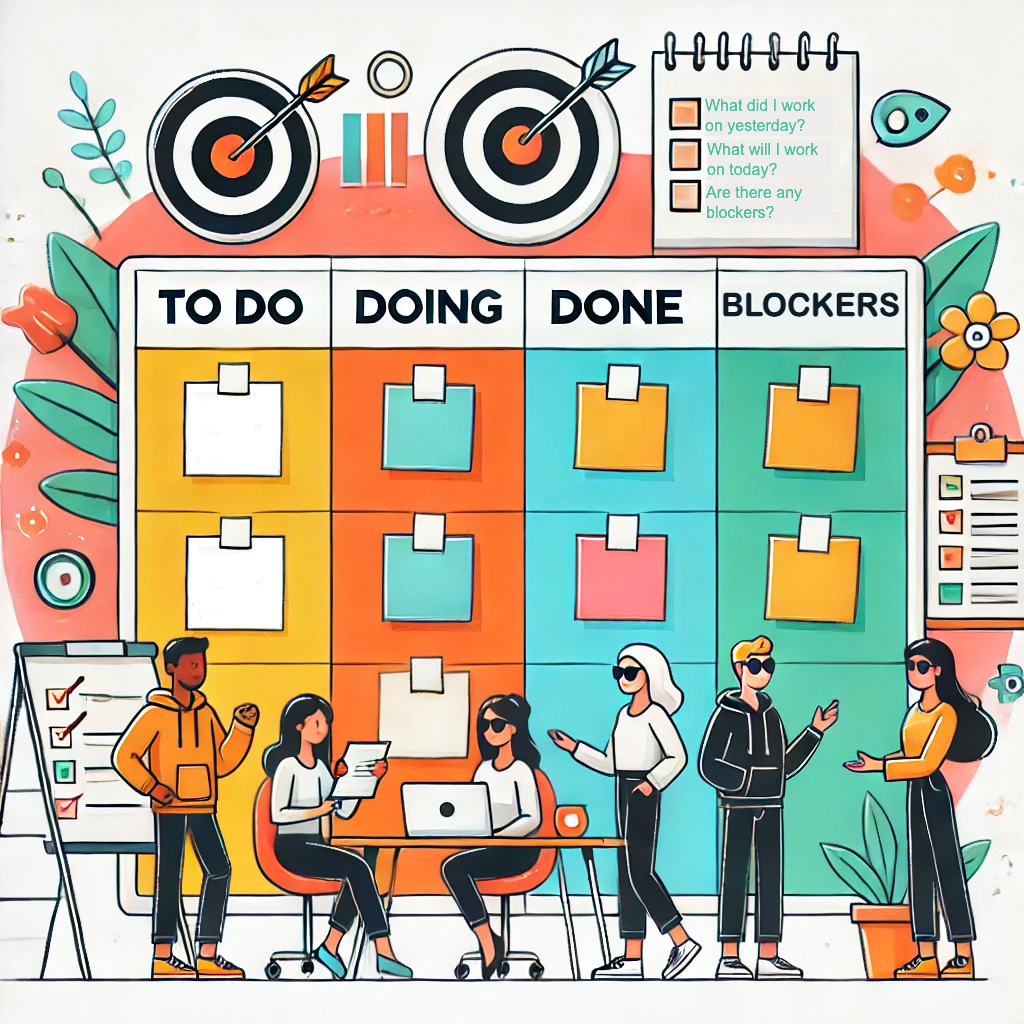Daily stand-ups are more than just a ritual for Agile teams. They are a powerful tool for ensuring alignment, encouraging collaboration, and addressing obstacles before they derail progress. When done right, stand-ups foster a culture of accountability and focus, enabling teams to consistently deliver value.
In this article, I’ll share insights into the purpose of daily stand-ups and actionable best practices to make them impactful.
What are daily stand-ups

A daily stand-up is a time-boxed meeting, usually 15 minutes, where team members come together to:
- Share progress on tasks
- Highlight challenges or blockers
- Align priorities for the day
These meetings help maintain clarity and momentum, ensuring that every individual knows how their work ties into the bigger picture.
Why daily stand-ups matter
| Purpose | Why It’s Important |
|---|---|
| Promote Team Transparency | Helps everyone understand what others are working on, reducing miscommunication and silos. |
| Identify Blockers Quickly | Allows the team to address roadblocks early before they escalate and disrupt the sprint. |
| Maintain Focus on Goals | Aligns daily work with the sprint objectives and overall product vision. |
| Foster Accountability | Encourages team members to take ownership of their tasks and commitments. |
| Encourage Collaboration | Provides a forum for cross-functional teams to align and help each other succeed. |
Best practices for effective daily stand-ups
Making daily stand-ups effective requires discipline and intentionality.
Here’s how to ensure your stand-ups drive results:-
| Best Practice | Why It Works | How to Implement |
|---|---|---|
| Time-box the meeting | Keeps the meeting focused and efficient, respecting everyone’s time. | Limit stand-ups to 15 minutes. Use a timer to ensure discussions don’t run over. |
| Set a clear agenda | Prevents the meeting from becoming a chaotic discussion. | Use the classic 3-question framework — 1. What did I work on yesterday? 2. What will I work on today? 3. Are there any blockers? |
| Are there any blockers? | Highlights obstacles that might hinder progress and ensures timely resolutions. | Encourage team members to share blockers honestly and openly during stand-ups. |
| Stand up (literally) | Encourages brevity and discourages lengthy updates. | For remote teams, ensure cameras are on for active engagement. |
| Focus on blockers | Prevents updates from turning into status reports and drives actionable discussions. | Focus on blockers and defer non-essential discussions to follow-up meetings. |
| Use visual aids | Improves clarity and helps track progress more effectively. | Use tools like Jira or Trello to display sprint boards and the status of tasks. |
| Celebrate wins | Boosts team morale and reinforces positive behaviors. | Recognize key milestones or completed tasks during stand-ups. |
| Rotate facilitators | Ensures shared ownership of the process and keeps meetings dynamic. | Assign different team members to facilitate stand-ups weekly or bi-weekly. |
| Maintain consistent timing | Builds rhythm and ensures full participation. | Schedule the meeting at the same time daily and ensure all team members adhere to it. |
| Address complexity offline | Prevents the meeting from derailing into problem-solving sessions. | Set follow-ups to handle detailed discussions or technical issues that arise during stand-ups. |
Common pitfalls to avoid
Even with the best intentions, stand-ups can lose their effectiveness if not handled carefully. Here’s what to watch out for:-
- Turning stand-ups into status meetings – Updates should focus on team alignment, not reporting progress to a manager.
- Exceeding time limits – Long meetings lead to disengagement. Keep it brief and to the point.
- Skipping stand-ups – Regularity is key. Missing meetings creates misalignment and delays.
- Unclear objectives – Without a structure, stand-ups can become unproductive. Ensure the purpose is understood by all.
- Neglecting remote team members – Failing to engage distributed teams can result in exclusion. Use video calls and collaborative tools to ensure inclusivity.
Insights from industry leaders
Companies that prioritize Agile practices have used daily stand-ups to achieve remarkable success:-
- Spotify – Squads use daily stand-ups to manage dependencies across globally distributed teams. [Source]
- Slack – Engineering teams use stand-ups to prioritize tasks and unblock challenges, integrating tools like Jira to maintain alignment. [Source]
- Toyota – In the 1980s, Toyota implemented daily stand-up meetings as part of its lean manufacturing approach, aiming to improve communication and efficiency on the production floor. [Source]
- Adobe: Adobe Workfront emphasizes the importance of daily stand-up meetings in Agile methodologies, highlighting their role in fostering collaboration and addressing bottlenecks promptly. [Source]
Summarising…
Daily stand-ups are a deceptively simple practice with profound impacts when done correctly. They provide teams with a platform to align, adapt, and deliver with confidence. By focusing on collaboration and accountability while avoiding common pitfalls, your stand-ups can become the cornerstone of a high-performing Agile team.
Take Action
- Review your current stand-up practices.
- Apply the best practices shared here to enhance your team’s productivity.
Subscribe to our newsletter for actionable insights into Agile practices and product management strategies.







